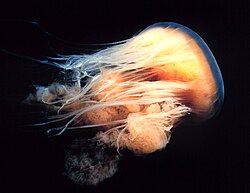Jellyfish and shark - Sant Hall - Smithsonian
The lion's mane jellyfish (Cyanea capillata) is the largest of all species of jellyfish. It lives in cold water, and has a lifespan of just a single year. They vary greatly in size, with smaller ones living in warmer waters (which has led some scientists to propose two sub-species rather than a single species). The bell can reach 8.2 feet (2.5 m) across, although smaller specimens have bells in the 20 inch (50 cm) range. The long, silvery tentacles can be anywhere from 30 feet to 100 feet (9.1 m to 30.5 m). They are very, very sticky, and are grouped into eight clusters of about a hundred each. Nearer the center of the lion's mane jellyfish is a mass of tangled, colored arms -- which gives the jelly its name (because this looks like a lion's mane). This mass is bright red in large specimens, but orange or tan in smaller ones. They feed on plankton, small fish, and other jellyfish. Their tentacles carry a poisonous toxin which can kill smaller animals, but which provides only a painful sting to human beings. Birds, large fish, and sea turtles are their primary predator.
Thresher sharks are found in the temperate and tropical oceans of the world. They prefer the open ocean, where they feed on bluefish, tuna, mackerel) squid, and cuttlefish. The tail is used to stun prey. They live to be about 20 years old, but breed infrequently. They are very prone to overfishing, and are not a threat to human beings.Relevantní obrázky
Relevantní články
Talířovka obrovskáTalířovka obrovská, také známá jako medúza žahavá, je největší známý druh medúzy. Vyskytuje se převážně v boreálních (subarktických) vodách Severního ledového oceánu a v severních částech Atlantiku a Pacifiku. Běžně ji lze spatřit i v Lamanšském průlivu, Irském moři, Severním moři a v západních vodách Skandinávie, na jih ke Kattegat a Øresund. Může také „zabloudit“ i do vod Baltského moře. Podobné medúzy, které mohou patřit ke stejnému druhu, obývají moře poblíž Austrálie a Nového Zélandu. Největší zdokumentovaný exemplář byl nalezen vyplavený na břehu Massachusettského zálivu v roce 1870 s rozměry zvonu o průměru 2,3 metry a chapadly dosahující délky 37 metrů. Talířovka obrovská byla po nějaký čas pozorována jižně od 42° s. š. ve větších zálivech východního pobřeží USA. .. pokračovat ve čtení







